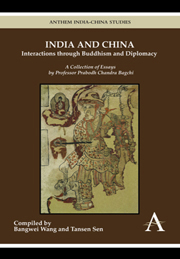 India and China: Interactions through Buddhism and Diplomacy
India and China: Interactions through Buddhism and Diplomacy from Part One
Published online by Cambridge University Press: 05 March 2012
While comparing the Avādanas with the Jātaka Stories Dr. Speyer says: “The avadāna type is nearly related to the Jātaka. Both concern edifying tales told with the purpose of inculcating moral precepts as taught by the Saddharma revealed by the Buddhas”. The stories of the Avadānaśataka have also the same character. Some of the stories may be labelled as Jātaka proper. A Jātaka, judged by the Pāli collection of Jātaka stories, contains a story of the past “within the outer frame-work, constituted by the introductory episode and the concluding identification”. A large number of stories of the Avadānaśataka contains a past story, within the frame-work of a present one with the identification. This identification is in some cases with the Buddha himself, and in other cases less important persons. Thus the presence of such different types of stories in the Avadānaśataka shows the importance of the collection in the development of the Jātaka stories.
The Chinese translation of the Avadānaśataka is very ancient. The title of the translation in Chinese is called Chuan tsi pai yuan king. The translation is attributed to Upasāka Che-kien of the Yue-che country. Che-kien was an Indo-Scythian Upasāka and is mentioned as such in all the Chinese Buddhist sources. It is said that he was at first at Lo-yang but on account of the political upheaval towards the end of the reign of Han Hien-ti (190–220 A.D.) was compelled to leave the north and to go to the south.
To save this book to your Kindle, first ensure [email protected] is added to your Approved Personal Document E-mail List under your Personal Document Settings on the Manage Your Content and Devices page of your Amazon account. Then enter the ‘name’ part of your Kindle email address below. Find out more about saving to your Kindle.
Note you can select to save to either the @free.kindle.com or @kindle.com variations. ‘@free.kindle.com’ emails are free but can only be saved to your device when it is connected to wi-fi. ‘@kindle.com’ emails can be delivered even when you are not connected to wi-fi, but note that service fees apply.
Find out more about the Kindle Personal Document Service.
To save content items to your account, please confirm that you agree to abide by our usage policies. If this is the first time you use this feature, you will be asked to authorise Cambridge Core to connect with your account. Find out more about saving content to Dropbox.
To save content items to your account, please confirm that you agree to abide by our usage policies. If this is the first time you use this feature, you will be asked to authorise Cambridge Core to connect with your account. Find out more about saving content to Google Drive.